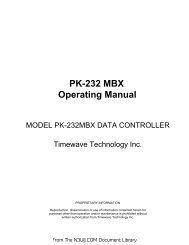You also want an ePaper? Increase the reach of your titles
YUMPU automatically turns print PDFs into web optimized ePapers that Google loves.
low-pass filter and UHF signal are high-pass filter, and thenapplied to the VHF and UHF power amplifier circuit separately.4-2-7 POWER AMPLIFIER CIRCUIT (PA UNIT)The power amplifier circuit amplifies the RF signals to thespecified output power.(1) VHF power amplifier circuitThe RF signal from the low-pass filter circuit is applied to theVHF power amplifier circuit (Q651, Q652) to obtain a stable100 W of RF output power. The amplified RF signal isapplied to the antenna connector (CHASSIS; J1) via thepower detector (D720, D721), transmit/receive switchingrelay (RL700) and low-pass filter (L723–L721, C728–C726,C728) circuits.(2) UHF power amplifier circuitThe RF signal from the high-pass filter is applied to theUHF power amplifier circuit (Q151, Q152) to obtain a stable75 W of RF output power. The amplified RF signal isapplied to the antenna connector (CHASSIS; J2) via thetransmit/receive switching circuit (D182–D185), low-passfilter (L181, L180, C188–C184) and power detector (D180,D181) circuits.4-2-8 ALC CIRCUIT (PA AND MAIN UNITS)The ALC (Automatic Level Control) circuit protects thepower amplifiers (PA unit; Q651, Q652 for VHF and Q151,Q152 for UHF) from a mismatched output load. Also, theALC circuit controls the gain of the transmit IF amplifier inorder for the transceiver to output even when the suppliedvoltage shifts, etc.The RF power level is detected at the power detector circuit(PA unit; D720–D721 for VHF, D180, D181 for UHF) to beconverted into DC voltages. The detected voltage (VFOR forVHF or UFOR for UHF) is passed through the switchingdiode, and are then applied to the differential amplifier(MAIN unit; <strong>IC</strong>1601b) via the FOR line. A reference voltage(POCV) for <strong>IC</strong>1601b is controlled by the [RF PWR] controlto output reference voltages. The output voltage is appliedto the transmit IF amplifier circuit (MAIN unit; Q1) as an ALCsignal to control the amplifier gain.When the VFOR/UFOR voltage increased, the output fromthe differential amplifier will be decrease to reduce the IFamplifier gain. This adjusts the RF output power until theVFOR/UFOR and POCV voltage are well balanced.4-3 PLL CIRCUITS<strong>IC</strong>-<strong>910H</strong> contains 2 PLL circuits and 1 local oscillator. TheVHF and UHF PLL circuits adopt “Icom’s original I-loop PLL”to obtain very fast lock up times.4-3-1 VHF PLL CIRCUIT (PLL UNIT)The VHF PLL circuit generates the 1st LO frequency, andthe signal is applied to the VHF 1st mixer circuit in the PAunit as the “A1LO” signal. The PLL circuit consists of a VCO,prescaler and DDS circuits.The signal generated at the VHF VCO circuit (Q191,D191–D194) is amplified at the buffer amplifiers (Q192,Q272), then applied to the prescaler circuit (<strong>IC</strong>271). Theprescaler circuit divides the applied signal, and outputs it tothe VHF DDS circuit (<strong>IC</strong>131) via the buffer amplifier (Q271).The VHF DDS circuit generates digital signals using theapplied signals as a clock frequency. The phase detectorsection in <strong>IC</strong>131 compares its phase with the reference frequencythat is generated at the reference oscillator (X512).<strong>IC</strong>131 outputs off-phase components as pulse signals viapins 51, 52.The output pulses are converted into DC voltage at the loopfilter circuit (<strong>IC</strong>161a) and then applied to the VHF VCO circuit.The D/A converter (R101–R124), low-pass filter(L101–L103, C103–C110) and buffer amplifier (<strong>IC</strong>101) circuitsare connected to the DDS output to convert the digitaloscillated signals into smooth analog signals.4-3-2 UHF PLL CIRCUIT (PLL UNIT)The UHF PLL circuit generates the 1st LO frequency, andthe signal is applied to the UHF 1st mixer circuit in the PAunit as the “B1LO” signal. The PLL circuit consists of a VCO,prescaler and DDS circuits.The signal generated at the UHF VCO circuit (Q391,D391–D394) is amplified at the buffer amplifiers (Q392,Q472), then applied to the prescaler circuit (<strong>IC</strong>471). Theprescaler circuit divides the applied signal, and outputs it tothe UHF DDS circuit (<strong>IC</strong>331) via the buffer amplifier (Q471).The D/A converter (R301–R324), low-pass filter(L301–L303, C103–C311) and buffer amplifier (<strong>IC</strong>301) circuitsare connected to the DDS output to convert the digitaloscillated signals into smooth analog signals.4-2-9 APC CIRCUIT (MAIN UNIT)The APC (Automatic Power Control) circuit protects thepower amplifiers on the PA unit from excessive current.Current drain of power amplifiers is detected by voltagedrops at a resistor (PA unit; R305) between VCC and PAHVlines. The original voltage (<strong>IC</strong>H) and dropped voltage (<strong>IC</strong>L)are applied to the APC differential amplifier (MAIN unit;<strong>IC</strong>1601d).The signal output from the differential amplifier reduces IFamplifier gain until these voltages are well-balanced.4-4 UX-910 (1200 MHz BAND UNIT)UX-910 is an optional 1200 MHz band unit for <strong>IC</strong>-<strong>910H</strong>. Thisunit covers 1240–1300 MHz frequency range.4-4-1 ANTENNA SWITCHING CIRCUIT (for RX)Received signals from the antenna connector (CHASSIS;J501) are applied to the transmit/receive switching circuit(RL51).The transmit/receive switching circuit leads receive signal tothe RF circuit while receiving. However, the circuit leads thetransmit signal from the RF power amplifier to the antennaconnector while transmitting.4 - 5From The <strong>N3UJJ</strong>.COM Document Library
















